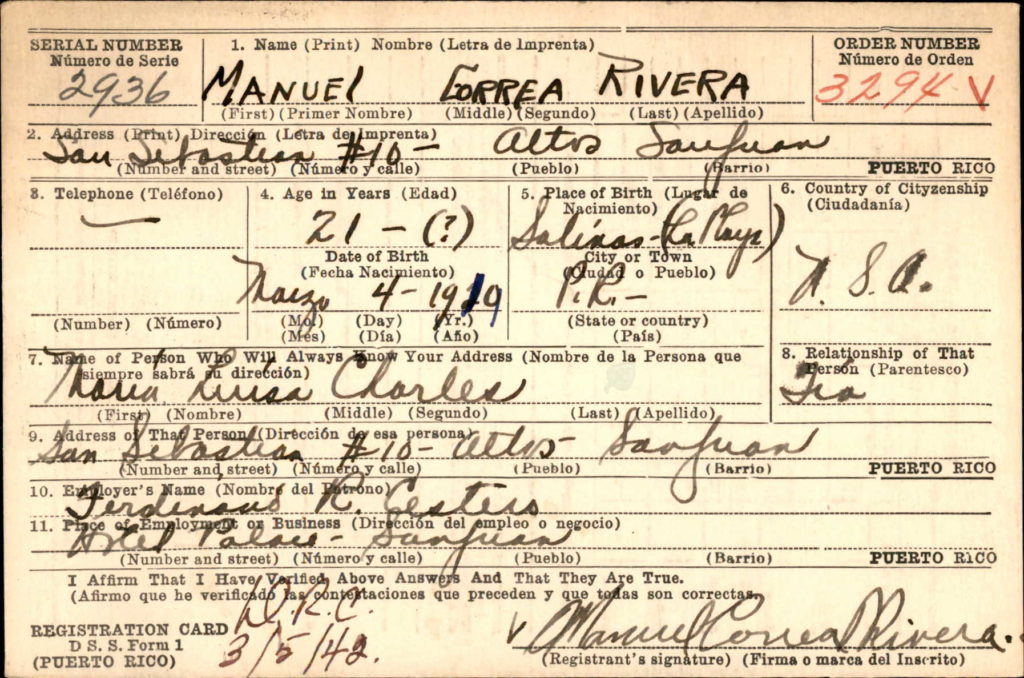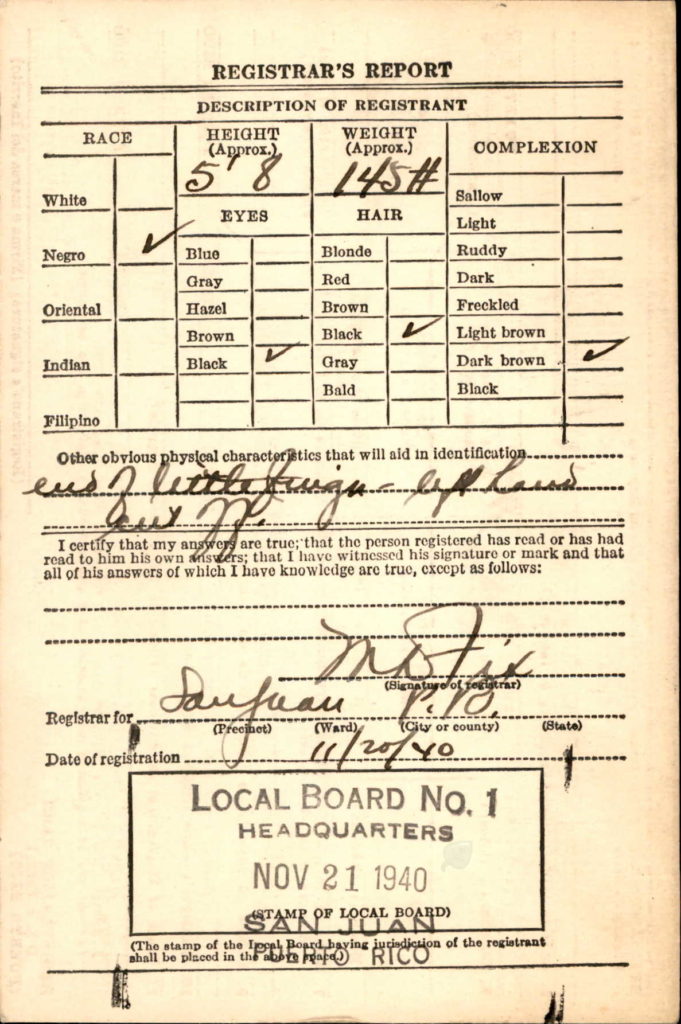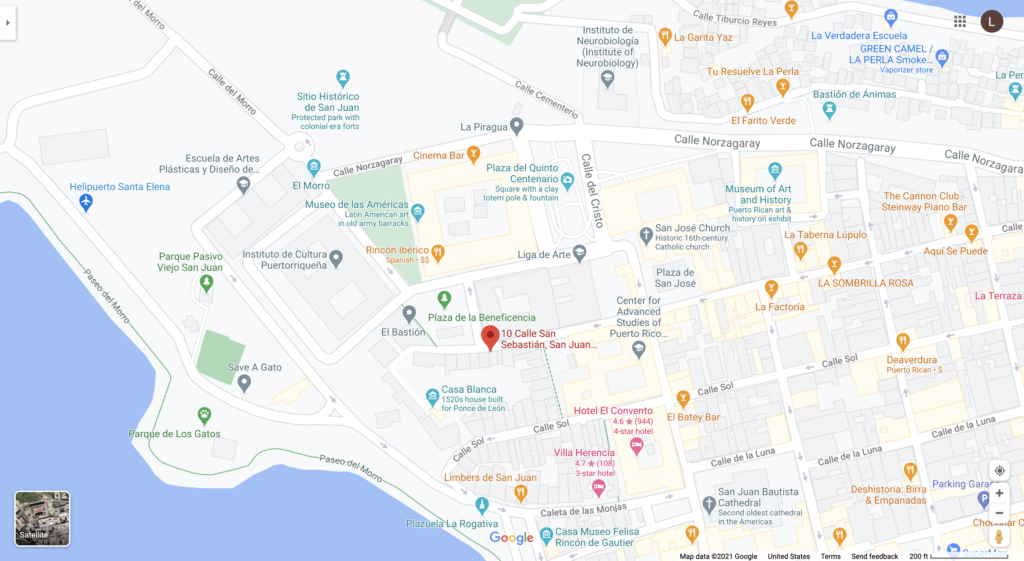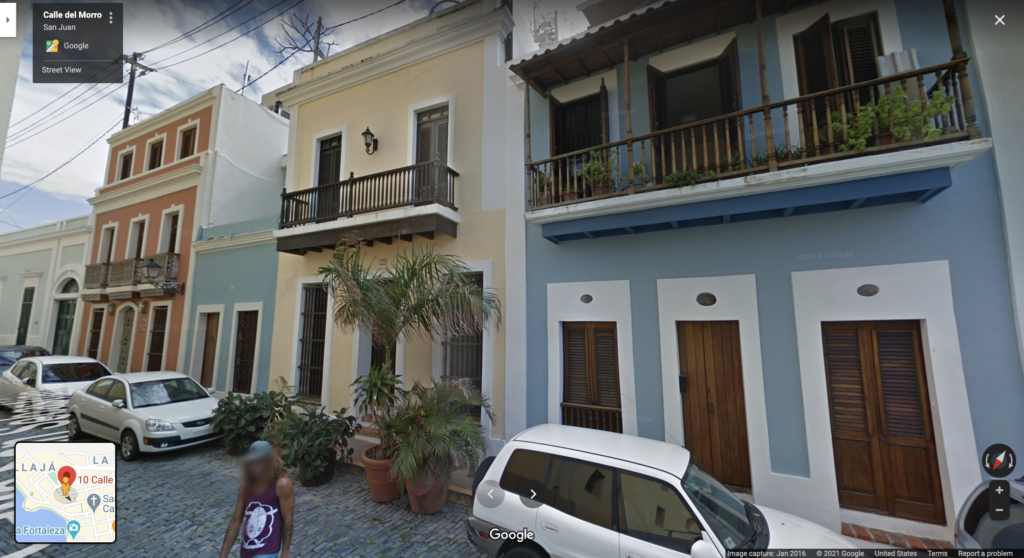This past week was my late grandfather’s birthday and in wanting to honor his memory and family I decided to switch around some topics and blog today about his own father, Manuel Correa Rivera. My grandfather was fairly young and would like to preserve his anonymity for now and so I will focus on my great-grandfather and his WWII Registration Card. These cards were recently updated last year in February 2020 so I had never seen my great-grandfather’s registration card before this. I will focus on breaking down the information held in the WWII Registration Card and what I was able to learn about my great-grandfather.
Overview - Manuel Correa rivera
Since I was born and raised outside of the island, there were certain ancestors and family members I never got a chance to meet when I was younger. That coupled with divorce or separation sometimes drove a deeper wedge between familiar relationships and family members. So though my great-grandfather was alive until I was about 2-3 years old I had never known him or have any photos with him (though we had traveled to Puerto Rico fairly quickly while we were that young). My own grandfather had an off/on again relationship with him, so I did not have much to start with when I began searching my Correa family. The small anecdotal stories sadly did not add much to finding out who this man was, and the lack of names also made searching for him harder.
It was not until years later after much searching and coincidences of life that I was able to learn more about and confirm vital details about my great-grandfather Manuel Correa Rivera (I posted about him years back on my 52 Ancestors Challenge). Recently with the help of this WWII Registration Card and finally obtaining a copy of his death certificate allowed me to piece together all the information I had discovered about Manuel Correa Rivera.
WWII Registration cards
Since I began using Ancestry about 16 years ago, I had always known about WWI and WWII Registration Cards. Though not many (if any direct ancestors) actually served in either war, these cards were useful for learning more information about my ancestors, sometimes something as trivial as a height, race, or defining features about them. Other times it pointed to other family members, birthdays, and towns of origin.
According to Ancestry.com “U.S., World War II Draft Cards Young Men, 1940-1947”:
“This database contains World War II draft registration cards from multiple registrations filled out by men in select states aged 18–44.
Historical Background
The U.S. officially entered World War II on 8 December 1941 following an attack on Pearl Harbor, Hawaii. About a year before, in October 1940, President Roosevelt had signed into law the first peacetime selective service draft in U.S. history because of rising world conflicts. Multiple registrations held between November 1940 and October 1946 signed up more than 50 million American men aged 18–45 for the draft.
Updates: 18 Feb 2020: Added new records from Massachusetts, New York City, Ohio, Puerto Rico, South Carolina, South Dakota, Tennessee and Wisconsin.”
A further look
Finding this WWII Registration Card came as a surprise because I had never seen it and I just thought somehow he had evaded being registered for WWII, but as you can see from the Ancestry description above, it wasn’t until the February 2020 update that new records were added for Puerto Rico. Below you can see both the front and back side of my great-grandfather’s WWII Registration Card. I will mention some areas that provided new information. The bolded section below contained new information of some sort for my research.


Page 1:
Name: Manuel Correa Rivera
Address: San Sebastián #10, Altos, San Juan
Telephone: N/A
Age in Years: 21 – (?)
Date of Birth: March 4, 1920 (later changed to 1919)
Place of Birth: Salinas (La Playa), Puerto Rico
Country of Citizenship: USA
Name of Person Who Will Always Know Your Address: María Luisa Charles
Relation of That Person: Tía (Aunt)
Address of that Person: San Sebastián #10, Altos, San Juan
Employer’s Name: Ferdinand R. Cestero
Place of Employment or Business: Hotel Palace – San Juan
Page 2:
Race: Negro (Black)
Height: 5’8
Eyes: Black
Weight: 145# (lbs)
Hair: Black
Complexion: Dark Brown
Other obvious physical characteristics that will aid in identification: end of little finger – left hand cut off.
Registrar for: San Juan, PR
Date of Registration: November 20, 1940
I had no idea that by November 1940 Manuel Correa was living with his aunt on Calle San Sebastián. Since I had seen the 1940 census record (created in April) and I had found an entry for a “Manolo” Correa Rivera listed as a chauffeur in San Juan working for a Luis Vahamonde Sánchez, a lawyer, I assumed this was his last residence before my grandfather was born. However, an aunt named María Luisa Charles was listed as living in San Sebastián #10 on the 1940 census, alone at the time, and a seamstress. Likely this aunt was actually named Luisa Correa Charles, daughter of Manuel Correa Ortiz and María Paulina Gustave/Charles who might have taken in or cared for Manuel Correa Rivera, my great-grandfather, after he was left orphaned at a young age. She spent time between San Juan and Salinas, their native town in the south, and likely this is what brought Manuel to the capital, to live with his aunt/extended family that could care for him. Below you can see where Calle San Sebastián is in relation to other things in the Viejo San Juan area as well as the street view. What’s truly insane is that I have walked this street many times since the Archivo Histórico Diocesano de San Juan is on this exact street not even a minute walk away from house #10. Next time I go I’ll have to take a closer look at this house!


By November 1940 it seems that my great-grandfather was working at a place called “Hotel Palace” in San Juan under a man named Ferdinand R. Cestero. From researching this hotel, it doesn’t seem to currently exist, at least not with its current name. Photos below show you how close it was to the harbor, so likely near Calle San Sebastián where Manuel lived. A blog titled: “Historia y Genealogía PR – Contando y Recordando” mentions that the hotel was on the corner of Calle McArthur and Calle “La Betancez”, and it was named one of the top ten hotels on the island in the 1950s. A pamphlet for the Hotel shows the grandeur and the height of the structure – not super common in the lower style of the Spanish buildings in Viejo San Juan. I know Calle McArthur is in the Old San Juan area, but I don’t see Calle La Betancez or what it likely should be called, “Calle Betances”, nearby either, possibly a street name change occurred before recent maps. I can’t find too much more on the Hotel Palace or what the structure today is used for.

My great-grandfather listed Ferdinand R. Cestero as his employer. Searching for Ferdinand I see that he died shortly after in 1945 in San Juan from Tuberculosis and at the time was listed as working for the Archivo Histórico – could that be what the hotel turned into? He was listed as “Ferdinand R. Cestero Lázaro” (other records list him as “Ferdinand R. Cestero Cestero”) in his death certificate and a son named Jorge Cestero Mangual is mentioned, who himself named his father and his employment as Hotel Palace in San Juan in his own WWII Registration Card. Given that Ferdinand was born about 1865, it is likely he was too old to register for WWII seeing as how he would have been about 75 years old.
The 1930 Census listed Ferdinand with his wife Teresa Mangual their son Jorge along with a servant, chauffeur, gardener, and a cook (the most I’ve seen so far! – not super typical for Puerto Rican families). By 1930, Ferdinand is listed as working for the Archivo Histórico as the Director, so I wonder if Hotel Palace was just the old address and easily recognizable versus the newer address for the Archivo Histórico? This also would explain his higher status in society and his ability to have live-in help. It makes me wonder how my great-grandfather came to know Ferdinand Cestero and find work with him. Currently I can’t find Ferdinand in the 1940 Federal Census.
Finally, it was interesting to see that my great-grandfather was missing part of his pinky finger on his left hand! Especially by the age of 20-21 years old. I wonder how it happened so young? I know my own grandfather, his son, also had a piece of his finger missing from an accident at work. My other great-grandfather on my maternal side also lost part of his finger while working, so it seems like injuries of this manner were quite common back in the days (especially for men working on sugar or coffee plantations). This was a detail I would have never learned about my great-grandfather in any other record. I also learned that he was 5’8, likely the height he stayed at since he was already 21 at the time. You can also see that his race was labeled as Negro (Black) and that he had a dark brown complexion. Though I am not dark myself, my grandfather, maternal uncle, brother, and cousins have continued to inherit shades of these traits. From the black and white photo above of my great-grandfather you can tell he had fairly dark features. We had always known that my grandfather’s family (the Correa) had an Afro-Boricua mix, but it wasn’t until recently that I discovered that the influence is closely associated to the Martinique and Guadeloupe ancestors I found on that side of the family – evident by the aunt’s surname of “Charles”, Luisa’s mother was born in Vieques and her grandparents were respectively from each French island. Her maternal great-grandmother was from Africa and brought to Martinique as a slave.
These WWII Registration Cards as you can see provide a lot of information outside of vital details about ancestors. Similarly, the WWI Registration Cards help to provide similar information. The only unfortunate thing is that these records only exist for men and not women, so we can only get a better glimpse at the lives of men from that era. Likewise, these are records that were produced once Puerto Rico became a part of the United States, I have not heard of or seen Spanish registration cards for men while the island belonged to Spain. There are however, other records outside of the Federal U.S. Censuses, Civil Registry, and Church Records that help provide more information on our ancestors.
More information to come!



